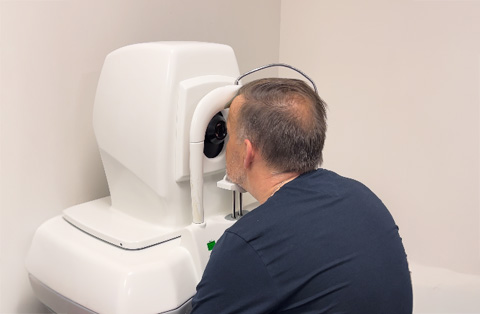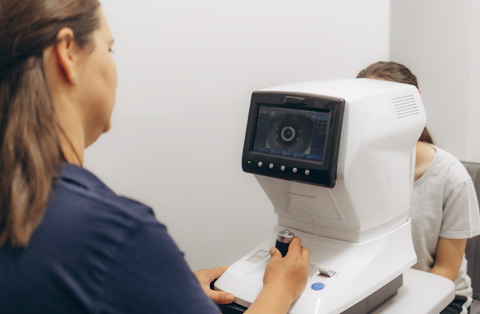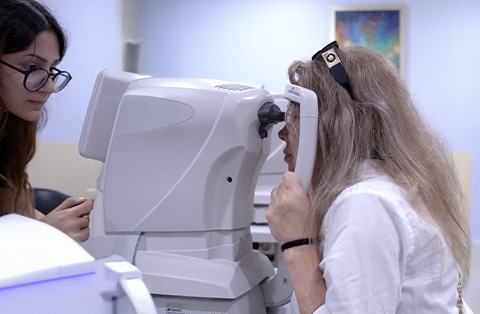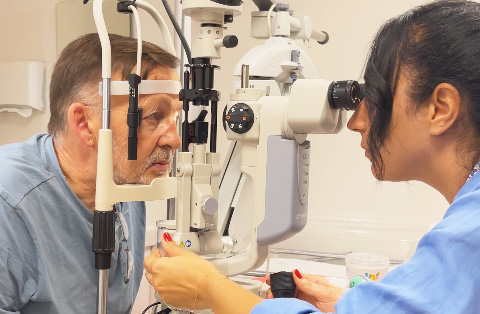LASEK surgery offers a safe, flap-free solution for clearer vision. It is ideal for those with thin corneas or active lifestyles. Achieve freedom from glasses with long-lasting results.
What Is LASEK?
LASEK (Laser-Assisted Sub-Epithelial Keratectomy) is a type of refractive eye surgery. It corrects common vision problems like myopia (nearsightedness), hyperopia (farsightedness), and astigmatism. LASEK reshapes the cornea using an excimer laser. This improves how light focuses on the retina, which sharpens vision.
Unlike LASIK, LASEK does not involve cutting a flap into the cornea. Instead, the surgeon loosens and moves the thin outer layer of the cornea called the epithelium. This layer is then replaced after the laser reshapes the underlying tissue.
LASEK is especially helpful for people with thin corneas or those not suitable for LASIK. It offers a good alternative with similar results in vision correction.
LASEK and LASIK: Key Differences in Procedure and Recovery
LASEK and LASIK both use lasers to correct vision, but they differ in technique and healing.
Procedure
In LASIK, the surgeon creates a thin flap in the cornea using a blade or femtosecond laser. This flap is lifted, the laser reshapes the corneal tissue, and then the flap is placed back.
In LASEK, no flap is created. Instead, the outer layer of the cornea (epithelium) is loosened with an alcohol solution and gently moved aside. After the laser reshapes the cornea, the epithelium is repositioned and a soft contact lens is placed to protect the eye during healing.
Recovery
LASIK patients often see clearly within 24 hours. Discomfort is minimal and short-lived.
LASEK has a longer recovery. Vision improves gradually over several days to weeks. There can be more discomfort in the first few days as the epithelium heals.
LASEK may be a better choice for patients with thin corneas, large pupils, or those at risk of eye trauma. LASIK offers faster visual recovery but requires a thicker cornea. The best option depends on individual eye structure and lifestyle.
LASEK and PRK Surgery
LASEK and PRK (Photorefractive Keratectomy) are similar surface laser eye surgeries. Both aim to correct vision without creating a corneal flap.
Procedure
In PRK, the surgeon completely removes the corneal epithelium before reshaping the underlying tissue with a laser. The epithelium grows back over several days.
In LASEK, the epithelium is not removed entirely. It is loosened with an alcohol solution, moved aside, and then repositioned after laser treatment.
Healing and Comfort
PRK involves slightly more discomfort during early healing since the epithelium is removed. LASEK may offer a bit more comfort because the epithelium is preserved and repositioned.
Both procedures have similar healing times and visual outcomes. Vision improves gradually over days to weeks.
Suitability
LASEK may be preferred in patients with very thin corneas or when a gentler approach to the corneal surface is needed. PRK remains widely used and is often chosen for athletes or those with a risk of eye injury, since it avoids a corneal flap entirely.
Both surgeries are safe and effective. The choice depends on eye structure, lifestyle, and surgeon recommendation.
Further Reading: LASIK vs LASEK vs PRK vs SMILE: Comparison Between Laser Eye Surgery Options
What Are the Benefits of LASEK Surgery for Vision Correction?
LASEK offers several advantages for patients who need vision correction but may not qualify for other laser eye surgeries.
Key benefits include:
Suitable for thin corneas: LASEK preserves more of the corneal structure, making it safer for those with thinner corneas who are not ideal candidates for LASIK.
No corneal flap: Since LASEK does not involve creating a flap, there is no risk of flap-related complications. This makes it a safer option for people at risk of eye trauma, such as athletes.
Lower dry eye risk: LASEK affects fewer corneal nerves compared to LASIK. This may reduce the chances of postoperative dry eye symptoms.
Effective vision correction: LASEK provides similar long-term vision outcomes as LASIK and PRK. Most patients achieve 20/20 vision or better after healing.
Good for active lifestyles: Without a flap, LASEK eyes are more stable in situations involving sudden pressure or contact.
While LASEK involves a longer recovery, its structural safety and effectiveness make it a valuable choice for the right candidates.
Who Is an Ideal Candidate for LASEK Eye Surgery?
LASEK is a good option for many people who want to reduce their need for glasses or contact lenses. It is especially suitable for those who may not qualify for LASIK.
Ideal candidates for LASEK include:
People with thin corneas: LASEK does not require a deep cut in the cornea, so it is safer for those with less corneal thickness.
Patients with active lifestyles: Those at risk of eye injuries, such as athletes or military personnel, may benefit from LASEK since it avoids the risk of flap displacement.
Individuals with mild to moderate refractive errors: LASEK effectively treats nearsightedness, farsightedness, and astigmatism.
Those with concerns about dry eyes: LASEK causes less nerve damage on the corneal surface compared to LASIK, which may reduce the risk of dry eye symptoms after surgery.
Patients with stable vision: Candidates should have had a stable prescription for at least one year.
Adults in good health: They should not have conditions like uncontrolled diabetes, autoimmune disorders, or other serious eye diseases.
A full eye exam is necessary to determine if LASEK is the safest and most effective option.
What Happens During a LASEK Procedure?
The LASEK procedure is a quick outpatient surgery. It usually takes about 15 minutes per eye. It is performed under local anesthesia using numbing eye drops.
Step-by-Step LASEK Treatment Process
Preparation: The eye is cleaned and numbed. A special device holds the eyelids open to prevent blinking.
Epithelium loosening: The surgeon applies a dilute alcohol solution to the eye for about 30 seconds. This softens the outer layer of the cornea (the epithelium).
Epithelium removal: The surgeon gently moves the softened epithelium to the side. It remains attached and will be replaced after the laser treatment.
Laser reshaping: An excimer laser precisely reshapes the corneal tissue underneath. This step takes only seconds. It corrects how light is focused on the retina.
Epithelium repositioning: The surgeon carefully places the epithelium back over the cornea.
Protection: A soft, clear contact lens is placed on the eye. This acts as a bandage and helps the eye heal.
After the procedure, the patient rests for a short time before going home. Vision is blurry at first, and full recovery takes a few days to weeks.
Disadvantages of Lasek Eye Surgery
LASEK is a safe and effective procedure, but like all surgeries, it has some disadvantages. Understanding these helps set realistic expectations.
Common disadvantages include:
Longer recovery: Vision improves more slowly than with LASIK. It may take several days to weeks to return to normal.
Initial discomfort: Patients often experience more pain, light sensitivity, and tearing in the first few days compared to LASIK.
Blurry vision early on: Clear vision is not immediate. Some patients may find this inconvenient if they need to return to work quickly.
Temporary night vision issues: Glare, halos, and poor night vision can occur during healing. These usually improve over time.
Use of bandage lens: A soft contact lens is worn for a few days to protect the eye, which requires extra care and follow-up.
Risk of haze: Some patients may develop corneal haze during healing. This is usually mild and temporary but may need treatment if it persists.
LASEK is not a difficult procedure, but it requires patience during recovery. Choosing a qualified surgeon and following all aftercare instructions can minimize these risks.
What Is the Recovery Time After LASEK Eye Surgery?
Recovery after LASEK takes longer than LASIK, but most patients return to normal activities within a week.
Typical recovery timeline:
First 3 to 5 days: Discomfort, light sensitivity, tearing, and blurry vision are common. The bandage contact lens remains in place during this time.
Day 4 or 5: The surgeon removes the contact lens once the epithelium has healed.
Week 1: Vision gradually improves. Many people can return to desk work or light activities, but vision may still fluctuate.
First month: Visual clarity continues to stabilize. Night vision may still be slightly hazy or have glare.
3 to 6 months: Full vision correction results are achieved. Most patients reach 20/20 vision or better.
Eye drops are used regularly during recovery to reduce inflammation and prevent infection. Follow-up visits are important to monitor healing and adjust treatment if needed.
What Are the Possible Side Effects of LASEK Eye Surgery?
LASEK is generally a safe procedure when performed by experienced surgeons. It is less invasive than LASIK because it does not involve cutting a corneal flap. However, as with any eye surgery, side effects can occur.
Possible side effects include:
Eye discomfort: Burning, stinging, and foreign body sensation are common for a few days after surgery.
Light sensitivity: The eyes may become sensitive to bright light during the first week.
Blurred vision: Vision is not clear immediately and can fluctuate during the first few weeks.
Dry eyes: Some patients may feel dryness or need artificial tears, especially in the early healing phase.
Halos or glare at night: These are temporary in most cases and improve as the eye heals.
Corneal haze: A cloudy appearance on the cornea may develop, but it is usually mild and temporary. Rarely, it may need treatment with medicated eye drops.
Infection or delayed healing: These are rare but possible. Regular follow-up visits help detect and manage any problems early.
While these side effects are usually mild and resolve over time, it is important to follow all post-operative instructions and attend follow-up appointments to ensure proper healing.
How Much Does LASEK Eye Surgery Cost?
The cost of LASEK eye surgery can vary widely depending on the country, clinic quality, and the surgeon’s experience.
Average cost ranges:
United States: LASEK usually costs between the mid to upper range for laser eye surgeries. Prices often include pre- and post-operative care, but not always. In the U.S., LASEK surgery typically ranges from $1,500 to $3,500 per eye, depending on the clinic and the specific technology used.
United Kingdom: Costs are slightly lower than in the US but still in the higher range. Some clinics offer flexible payment plans. In the UK, LASEK procedures generally cost between £1,500 and £3,100 per eye, varying based on the clinic's location and the technology utilized. Some clinics may offer financing options or package deals that include consultations and aftercare.
Western Europe: Countries like Germany, France, and the Netherlands offer similar pricing to the UK. The cost often reflects the high standard of care and regulatory oversight.
Türkiye: LASEK surgery in Türkiye is significantly more affordable. Türkiye has become a popular destination for medical tourism, offering LASEK surgery at more affordable prices, typically between $800 and $1,500 per eye.
Despite the lower prices, the quality of care matches international standards. Surgeons in Türkiye are well-trained, and clinics use advanced laser technology. Many patients from abroad choose Türkiye not just for affordability, but also for its experienced doctors and excellent patient care.
Patients considering medical travel to Türkiye benefit from both cost savings and access to world-class treatment. This makes it a popular destination for safe and effective vision correction.




